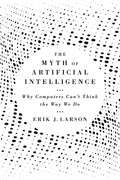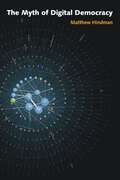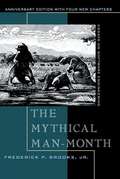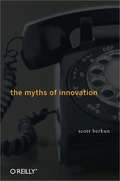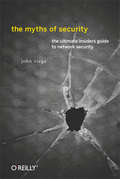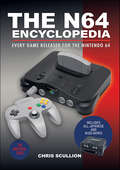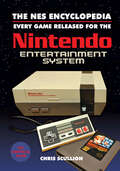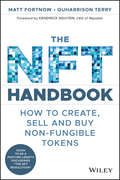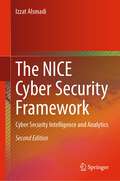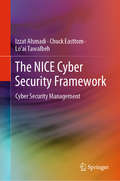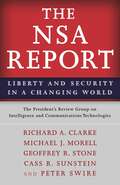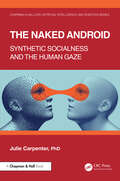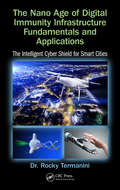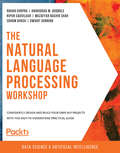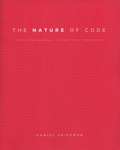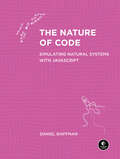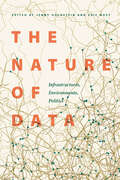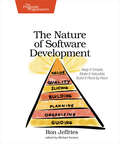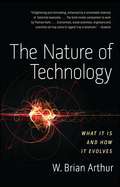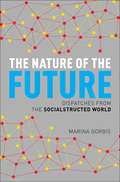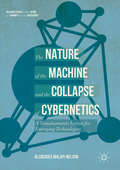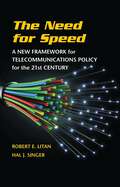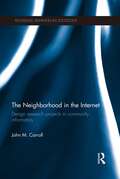- Table View
- List View
The Myth of Artificial Intelligence: Why Computers Can't Think the Way We Do
by Erik J. Larson“Artificial intelligence has always inspired outlandish visions—that AI is going to destroy us, save us, or at the very least radically transform us. Erik Larson exposes the vast gap between the actual science underlying AI and the dramatic claims being made for it. This is a timely, important, and even essential book.” —John Horgan, author of The End of Science Many futurists insist that AI will soon achieve human levels of intelligence. From there, it will quickly eclipse the most gifted human mind. The Myth of Artificial Intelligence argues that such claims are just that: myths. We are not on the path to developing truly intelligent machines. We don’t even know where that path might be. Erik Larson charts a journey through the landscape of AI, from Alan Turing’s early work to today’s dominant models of machine learning. Since the beginning, AI researchers and enthusiasts have equated the reasoning approaches of AI with those of human intelligence. But this is a profound mistake. Even cutting-edge AI looks nothing like human intelligence. Modern AI is based on inductive reasoning: computers make statistical correlations to determine which answer is likely to be right, allowing software to, say, detect a particular face in an image. But human reasoning is entirely different. Humans do not correlate data sets; we make conjectures sensitive to context—the best guess, given our observations and what we already know about the world. We haven’t a clue how to program this kind of reasoning, known as abduction. Yet it is the heart of common sense. Larson argues that all this AI hype is bad science and bad for science. A culture of invention thrives on exploring unknowns, not overselling existing methods. Inductive AI will continue to improve at narrow tasks, but if we are to make real progress, we must abandon futuristic talk and learn to better appreciate the only true intelligence we know—our own.
The Myth of Digital Democracy
by Matthew HindmanIs the Internet democratizing American politics? Do political Web sites and blogs mobilize inactive citizens and make the public sphere more inclusive? The Myth of Digital Democracy reveals that, contrary to popular belief, the Internet has done little to broaden political discourse but in fact empowers a small set of elites--some new, but most familiar. Matthew Hindman argues that, though hundreds of thousands of Americans blog about politics, blogs receive only a miniscule portion of Web traffic, and most blog readership goes to a handful of mainstream, highly educated professionals. He shows how, despite the wealth of independent Web sites, online news audiences are concentrated on the top twenty outlets, and online organizing and fund-raising are dominated by a few powerful interest groups. Hindman tracks nearly three million Web pages, analyzing how their links are structured, how citizens search for political content, and how leading search engines like Google and Yahoo! funnel traffic to popular outlets. He finds that while the Internet has increased some forms of political participation and transformed the way interest groups and candidates organize, mobilize, and raise funds, elites still strongly shape how political material on the Web is presented and accessed. The Myth of Digital Democracy. debunks popular notions about political discourse in the digital age, revealing how the Internet has neither diminished the audience share of corporate media nor given greater voice to ordinary citizens.
The Mythical Man-Month Essays on Software Engineering Anniversary Edition
by Frederick P. BrooksFew books on software project management have been as influential and timeless as The Mythical Man-Month. With a blend of software engineering facts and thought-provoking opinions, Fred Brooks offers insight for anyone managing complex projects. These essays draw from his experience as project manager for the IBM System/360 computer family and then for OS/360, its massive software system. Now, 20 years after the initial publication of his book, Brooks has revisited his original ideas and added new thoughts and advice, both for readers already familiar with his work and for readers discovering it for the first time. The added chapters contain (1) a crisp condensation of all the propositions asserted in the original book, including Brooks' central argument in The Mythical Man-Month: that large programming projects suffer management problems different from small ones due to the division of labor that the conceptual integrity of the product is therefore critical; and that it is difficult but possible to achieve this unity; (2) Brooks' view of these propositions a generation later; (3) a reprint of his classic 1986 paper "No Silver Bullet"; and (4) today's thoughts on the 1986 assertion, "There will be no silver bullet within ten years. "
The Myths of Innovation
by Scott BerkunHow do we know if a hot new technology will succeed or fail? Most of us, even experts, get it wrong all the time. We depend more than we realize on wishful thinking and romanticized ideas of history. In the new paperback edition of this fascinating book, a book that has appeared on MSNBC, CNBC, Slashdot.org, Lifehacker.com and in The New York Times, bestselling author Scott Berkun pulls the best lessons from the history of innovation, including the recent software and web age, to reveal powerful and suprising truths about how ideas become successful innovations -- truths people can easily apply to the challenges of today. Through his entertaining and insightful explanations of the inherent patterns in how Einstein’s discovered E=mc2 or Tim Berner Lee’s developed the idea of the world wide web, you will see how to develop existing knowledge into new innovations.Each entertaining chapter centers on breaking apart a powerful myth, popular in the business world despite it's lack of substance. Through Berkun's extensive research into the truth about innovations in technology, business and science, you’ll learn lessons from the expensive failures and dramatic successes of innovations past, and understand how innovators achieved what they did -- and what you need to do to be an innovator yourself. You'll discover:Why problems are more important than solutionsHow the good innovation is the enemy of the greatWhy children are more creative than your co-workersWhy epiphanies and breakthroughs always take timeHow all stories of innovations are distorted by the history effectHow to overcome people’s resistance to new ideasWhy the best idea doesn’t often winThe paperback edition includes four new chapters, focused on appling the lessons from the original book, and helping you develop your skills in creative thinking, pitching ideas, and staying motivated."For centuries before Google, MIT, and IDEO, modern hotbeds of innovation, we struggled to explain any kind of creation, from the universe itself to the multitudes of ideas around us. While we can make atomic bombs, and dry-clean silk ties, we still don’t have satisfying answers for simple questions like: Where do songs come from? Are there an infinite variety of possible kinds of cheese? How did Shakespeare and Stephen King invent so much, while we’re satisfied watching sitcom reruns? Our popular answers have been unconvincing, enabling misleading, fantasy-laden myths to grow strong."-- Scott Berkun, from the text"Berkun sets us free to change the world."-- Guy Kawasaki, author of Art of the StartScott was a manager at Microsoft from 1994-2003, on projects including v1-5 (not 6) of Internet Explorer. He is the author of three bestselling books, Making Things Happen, The Myths of Innovation and Confessions of a Public Speaker. He works full time as a writer and speaker, and his work has appeared in The New York Times, Forbes magazine, The Economist, The Washington Post, Wired magazine, National Public Radio and other media. He regularly contributes to Harvard Business Review and Bloomberg Businessweek, has taught creative thinking at the University of Washington, and has appeared as an innovation and management expert on MSNBC and on CNBC. He writes frequently on innovation and creative thinking at his blog: scottberkun.com and tweets at @berkun.
The Myths of Security: What the Computer Security Industry Doesn't Want You to Know
by John ViegaIf you think computer security has improved in recent years, The Myths of Security will shake you out of your complacency. Longtime security professional John Viega, formerly Chief Security Architect at McAfee, reports on the sorry state of the industry, and offers concrete suggestions for professionals and individuals confronting the issue. Why is security so bad? With many more people online than just a few years ago, there are more attackers -- and they're truly motivated. Attacks are sophisticated, subtle, and harder to detect than ever. But, as Viega notes, few people take the time to understand the situation and protect themselves accordingly. This book tells you:Why it's easier for bad guys to "own" your computer than you thinkWhy anti-virus software doesn't work well -- and one simple way to fix itWhether Apple OS X is more secure than WindowsWhat Windows needs to do betterHow to make strong authentication pervasiveWhy patch management is so badWhether there's anything you can do about identity theftFive easy steps for fixing application security, and moreProvocative, insightful, and always controversial, The Myths of Security not only addresses IT professionals who deal with security issues, but also speaks to Mac and PC users who spend time online.
The N64 Encyclopedia: Every Game Released for the Nintendo 64
by Chris ScullionThis comprehensive guide to the iconic Nintendo 64 game consol covers every game produced for the system.Although the Nintendo 64 struggled in the shadow of the bold and shiny Sony PlayStation, it was beloved by nearly everyone who owned one. Despite its relatively small library, the N64 had a number of groundbreaking titles, such as Super Mario 64, GoldenEye 007, Mario Kart 64 and The Legend of Zelda: Ocarina of Time. Each of these revolutionized the way we play and remain the stuff of legend for fans. The N64 Encyclopedia covers these major gaming touchstones, along with every other game released for the system, no matter how obscure. It also includes every game released in Japan, even those intended for the ill-fated Nintendo 64DD add-on which never left the country. With over four hundred games covered, screenshots for every title and a light-hearted writing style designed to make reading it a fun experience, The N64 Encyclopedia is the definitive guide to a revolutionary gaming system.
The NES Encyclopedia: Every Game Released for the Nintendo Entertainment System
by Chris ScullionA comprehensive, colorful guide to every game ever released on the classic Nintendo Entertainment System. One of the most iconic video game systems, the NES is credited with saving the American video games industry in the early 1980s. The NES Encyclopedia is the first ever complete reference guide to every game released on the Nintendo Entertainment System, Nintendo&’s first industry-defining video game system. As well as covering all 714 officially licensed NES games, the book also includes more than 160 unlicensed games released during its lifespan, giving for the first time a definitive history of this important console's full library. Written by a retro gaming expert with 30 years of gaming experience and a penchant for bad jokes, TheNES Encyclopedia promises to be both informative and entertaining. The NES continues to enjoy a strong cult following among Nintendo fans and gamers in general with wide varieties of officially licensed merchandise proving ever popular. Nintendo&’s most recent console, the Switch, is the fastest selling video game console of all time in the United States and Japan. Nintendo launched a variety of classic NES games for download on the system, meaning a new audience of gamers is due to discover the NES for the first time if they have not already. Praise for The NES Encyclopedia &“As a catalog of all 876 NES games, this work is unique in its breadth of coverage and will be of great interest to old-school video gamers and collectors.&” —Booklist &“A definitive resource that is more than worthy of the title &‘Encyclopedia.&’ &” —Nintendo World Report
The NFT Handbook: How to Create, Sell and Buy Non-Fungible Tokens
by Matt Fortnow QuHarrison TerryThe NFT Handbook is a detailed guide on how to create, sell and buy non-fungible tokens without the need for a technical background. Learn exactly what NFTs are, how they evolved, and why they have value.We’ll delve into the different types and aspects of NFTs and discuss the different NFT marketplaces and the pros and cons of each. Create Your Own NFTs: Step by step instructions on all aspects of NFT creation, including what types of content to use, where to source content, adding artistic design, writing the NFT’s description, adding optional unlockable content and setting an optional ongoing royalty. Mint Your NFTs: You’ll learn the process of how to get your NFTs on the blockchain. Sell Your NFTs: We’ll go through the whole process including creating a collection, and the different options such as setting a price or starting an auction. Buy NFTs: What you’ll need to bid on and purchase NFTs, and how to avoid getting scammed. You’ll also get a primer on blockchain, particularly the Ethereum cryptocurrency and “gas” fees. You’ll also be shown step by step how to create, secure and fund your own cryptocurrency wallet, where you’ll store your NFTs and cryptocurrency. Whether you’re experienced with the blockchain and crypto or a complete noob (beginner), The NFT Handbook will guide you in the process of creating, minting, selling and buying NFTs.
The NICE Cyber Security Framework: Cyber Security Intelligence and Analytics
by Izzat AlsmadiThis updated textbook is for courses in cyber security education that follow the National Initiative for Cybersecurity Education (NICE) framework which adopts the Competency- Based Education (CBE) method. The book creates content based on the Knowledge, Skills and Abilities (a.k.a. KSAs) described in the NICE framework. This book focuses on cyber analytics and intelligence areas. The book has 18 chapters: Introduction, Acquisition Management, Continuity Planning and Disaster Recovery, Cyber Defense Analysis and Support, Cyber Intelligence, Cyber Intelligence Analysis, Cyber Operational Planning, Cyber Policy and Strategy Management, Cyber Threat Analysis, Cybersecurity Management, Forensics Analysis, Identity Management, Incident Response, Collection Operations, Computer Network Defense, Data Analysis, Threat Analysis and last chapter, Vulnerability Assessment.
The NICE Cyber Security Framework: Cyber Security Management
by Chuck Easttom Izzat Alsmadi Lo’ai TawalbehThis textbook covers security controls and management. It is for courses in cyber security education that follow National Initiative for Cybersecurity Education (NICE) work roles and framework that adopt the Competency-Based Education (CBE) method. The book follows the CBE general framework, meaning each chapter contains three sections, knowledge and questions, and skills/labs for skills and sbilities. The author makes an explicit balance between knowledge and skills material in information security, giving readers immediate applicable skills. The book is divided into several parts, including: Information Assurance / Encryption; Information Systems Security Management; Information Systems / Network Security; Information Technology Management; IT Management; and IT Risk Management.
The NSA Report: Liberty and Security in a Changing World
by Cass R. Sunstein Richard A. Clarke Geoffrey R. Stone Peter Swire Michael J. Morell President's Review Group on Intelligence and Communications Technologies, TheThe official report that has shaped the international debate about NSA surveillance"We cannot discount the risk, in light of the lessons of our own history, that at some point in the future, high-level government officials will decide that this massive database of extraordinarily sensitive private information is there for the plucking. Americans must never make the mistake of wholly 'trusting' our public officials."—The NSA ReportThis is the official report that is helping shape the international debate about the unprecedented surveillance activities of the National Security Agency. Commissioned by President Obama following disclosures by former NSA contractor Edward J. Snowden, and written by a preeminent group of intelligence and legal experts, the report examines the extent of NSA programs and calls for dozens of urgent and practical reforms. The result is a blueprint showing how the government can reaffirm its commitment to privacy and civil liberties—without compromising national security.
The Naked Android: Synthetic Socialness and the Human Gaze (Chapman & Hall/CRC Artificial Intelligence and Robotics Series)
by Julie CarpenterThe Naked Android: Synthetic Socialness and the Human Gaze illuminates the connection between the stories people tell, their expectations of what a robot is, and how these beliefs and values manifest in how real robots are designed and used.The introduction of the “human gaze” articulates how peoples’ expectations and perceptions about robots are ultimately based on deeply personal cultural interpretations of what is artificial or human and what problems social robots should –or should not –solve. The Naked Android clarifies how human qualities like understanding and desire are designed into robots as mediums as well as projected onto them by the people who live with them.By investigating the fluidity of identities across human culture and social robotics, this book unpacks the contextual complexities of their interactions and mutual influences. Using ethnographic methods including in-depth interviews with a variety of stakeholders, each chapter explores how people are designing social robots, the experience of living with robots, and people whose jobs it is to dream about a future integrated with robots.Key Features: Introduces the concept of the “human gaze” (and the “robot gaze”) as means of understanding how people live with robots. Each chapter includes in-depth interviews with people who make, live with, or create art about robots. Using ethnographic methods, paints a vivid description of the interconnecting influences of science fiction, human imagination, and real technology.
The Nano Age of Digital Immunity Infrastructure Fundamentals and Applications: The Intelligent Cyber Shield for Smart Cities
by Rocky TermaniniPresent anti-virus technologies do not have the symmetrical weaponry to defeat massive DDoS attacks on smart cities. Smart cities require a new set of holistic and AI-centric cognitive technology, such as autonomic components that replicate the human immune system, and a smart grid that connects all IoT devices. The book introduces Digital Immunity and covers the human immune system, massive distributed attacks (DDoS) and the future generations cyber attacks, the anatomy and critical success factors of smart city, Digital Immunity and the role of the Smart Grid, how Digital Immunity defends the smart city and annihilates massive malware, and Digital Immunity to combat global cyber terrorism.
The Natural Language Processing Workshop: Confidently design and build your own NLP projects with this easy-to-understand practical guide
by Dwight Gunning Rohan Chopra Sohom Ghosh Nipun Sadvilkar Aniruddha M. Godbole Muzaffar Bashir ShahMake NLP easy by building chatbots and models, and executing various NLP tasks to gain data-driven insights from raw text dataKey FeaturesGet familiar with key natural language processing (NLP) concepts and terminologyExplore the functionalities and features of popular NLP toolsLearn how to use Python programming and third-party libraries to perform NLP tasksBook DescriptionDo you want to learn how to communicate with computer systems using Natural Language Processing (NLP) techniques, or make a machine understand human sentiments? Do you want to build applications like Siri, Alexa, or chatbots, even if you've never done it before?With The Natural Language Processing Workshop, you can expect to make consistent progress as a beginner, and get up to speed in an interactive way, with the help of hands-on activities and fun exercises.The book starts with an introduction to NLP. You'll study different approaches to NLP tasks, and perform exercises in Python to understand the process of preparing datasets for NLP models. Next, you'll use advanced NLP algorithms and visualization techniques to collect datasets from open websites, and to summarize and generate random text from a document. In the final chapters, you'll use NLP to create a chatbot that detects positive or negative sentiment in text documents such as movie reviews.By the end of this book, you'll be equipped with the essential NLP tools and techniques you need to solve common business problems that involve processing text.What you will learnObtain, verify, clean and transform text data into a correct format for useUse methods such as tokenization and stemming for text extractionDevelop a classifier to classify comments in Wikipedia articlesCollect data from open websites with the help of web scrapingTrain a model to detect topics in a set of documents using topic modelingDiscover techniques to represent text as word and document vectorsWho this book is forThis book is for beginner to mid-level data scientists, machine learning developers, and NLP enthusiasts. A basic understanding of machine learning and NLP is required to help you grasp the topics in this workshop more quickly.
The Nature Of Code
by Daniel ShiffmanHow can we capture the unpredictable evolutionary and emergent properties of nature in software? How can understanding the mathematical principles behind our physical world help us to create digital worlds? This book focuses on a range of programming strategies and techniques behind computer simulations of natural systems, from elementary concepts in mathematics and physics to more advanced algorithms that enable sophisticated visual results. Readers will progress from building a basic physics engine to creating intelligent moving objects and complex systems, setting the foundation for further experiments in generative design. Subjects covered include forces, trigonometry, fractals, cellular automata, self-organization, and genetic algorithms. The books examples are written in Processing, an open-source language and development environment built on top of the Java programming language. On the books website (http: //www. natureofcode. com), the examples run in the browser via Processings JavaScript mode.
The Nature of Code (PDF)
by Daniel ShiffmanHow can we capture the unpredictable evolutionary and emergent properties of nature in software? How can understanding the mathematical principles behind our physical world help us to create digital worlds? This book focuses on a range of programming strategies and techniques behind computer simulations of natural systems, from elementary concepts in mathematics and physics to more advanced algorithms that enable sophisticated visual results. Readers will progress from building a basic physics engine to creating intelligent moving objects and complex systems, setting the foundation for further experiments in generative design. Subjects covered include forces, trigonometry, fractals, cellular automata, self-organization, and genetic algorithms. The books examples are written in Processing, an open-source language and development environment built on top of the Java programming language. On the books website (http: //www. natureofcode. com), the examples run in the browser via Processings JavaScript mode.
The Nature of Code: Simulating Natural Systems with JavaScript
by Daniel ShiffmanAll aboard The Coding Train! This beginner-friendly creative coding tutorial is designed to grow your skills in a fun, hands-on way as you build simulations of real-world phenomena with &“The Coding Train&” YouTube star Daniel Shiffman.What if you could re-create the awe-inspiring flocking patterns of birds or the hypnotic dance of fireflies—with code? For over a decade, The Nature of Code has empowered countless readers to do just that, bridging the gap between creative expression and programming. This innovative guide by Daniel Shiffman, creator of the beloved Coding Train, welcomes budding and seasoned programmers alike into a world where code meets playful creativity.This JavaScript-based edition of Shiffman&’s groundbreaking work gently unfolds the mysteries of the natural world, turning complex topics like genetic algorithms, physics-based simulations, and neural networks into accessible and visually stunning creations.Embark on this extraordinary adventure with projects involving:A physics engine: Simulate the push and pull of gravitational attraction.Flocking birds: Choreograph the mesmerizing dance of a flock.Branching trees: Grow lifelike and organic tree structures.Neural networks: Craft intelligent systems that learn and adapt.Cellular automata: Uncover the magic of self-organizing patterns.Evolutionary algorithms: Play witness to natural selection in your code.Shiffman&’s work has transformed thousands of curious minds into creators, breaking down barriers between science, art, and technology, and inviting readers to see code not just as a tool for tasks but as a canvas for boundless creativity.Whether you&’re deciphering the elegant patterns of natural phenomena or crafting your own digital ecosystems, Shiffman&’s guidance is sure to inform and inspire. The Nature of Code is not just about coding; it&’s about looking at the natural world in a new way and letting its wonders inspire your next creation. Dive in and discover the joy of turning code into art—all while mastering coding fundamentals along the way.NOTE: All examples are written with p5.js, a JavaScript library for creative coding, and are available on the book's website.
The Nature of Data: Infrastructures, Environments, Politics
by Jenny Goldstein Eric NostWhen we look at some of the most pressing issues in environmental politics today, it is hard to avoid data technologies. Big data, artificial intelligence, and data dashboards all promise &“revolutionary&” advances in the speed and scale at which governments, corporations, conservationists, and even individuals can respond to environmental challenges. By bringing together scholars from geography, anthropology, science and technology studies, and ecology, The Nature of Data explores how the digital realm is a significant site in which environmental politics are waged. This collection as a whole makes the argument that we cannot fully understand the current conjuncture in critical, global environmental politics without understanding the role of data platforms, devices, standards, and institutions. In particular, The Nature of Data addresses the contested practices of making and maintaining data infrastructure, the imaginaries produced by data infrastructures, the relations between state and civil society that data infrastructure reworks, and the conditions under which technology can further socio-ecological justice instead of re-entrenching state and capitalist power. This innovative volume presents some of the first research in this new but rapidly growing subfield that addresses the role of data infrastructures in critical environmental politics.
The Nature of Software Development: Keep It Simple, Make It Valuable, Build It Piece by Piece
by Ron JeffriesYou need to get value from your software project. You need it "free, now, and perfect." We can't get you there, but we can help you get to "cheaper, sooner, and better." This book leads you from the desire for value down to the specific activities that help good Agile projects deliver better software sooner, and at a lower cost. Using simple sketches and a few words, the author invites you to follow his path of learning and understanding from a half century of software development and from his engagement with Agile methods from their very beginning.The book describes software development, starting from our natural desire to get something of value. Each topic is described with a picture and a few paragraphs. You're invited to think about each topic; to take it in. You'll think about how each step into the process leads to the next. You'll begin to see why Agile methods ask for what they do, and you'll learn why a shallow implementation of Agile can lead to only limited improvement.This is not a detailed map, nor a step-by-step set of instructions for building the perfect project. There is no map or instructions that will do that for you.You need to build your own project, making it a bit more perfect every day. To do that effectively, you need to build up an understanding of the whole process.This book points out the milestones on your journey of understanding the nature of software development done well. It takes you to a location, describes it briefly, and leaves you to explore and fill in your own understanding.What You Need:You'll need your Standard Issue Brain, a bit of curiosity, and a desire to build your own understanding rather than have someone else's detailed ideas poured into your head.
The Nature of Technology: What It Is and How It Evolves
by W. Brian Arthur“More than anything else technology creates our world. It creates our wealth, our economy, our very way of being,” says W. Brian Arthur. Yet despite technology’s irrefutable importance in our daily lives, until now its major questions have gone unanswered. Where do new technologies come from? What constitutes innovation, and how is it achieved? Does technology, like biological life, evolve? In this groundbreaking work, pioneering technology thinker and economist W. Brian Arthur answers these questions and more, setting forth a boldly original way of thinking about technology. The Nature of Technology is an elegant and powerful theory of technology’s origins and evolution. Achieving for the development of technology what Thomas Kuhn’s The Structure of Scientific Revolutions did for scientific progress, Arthur explains how transformative new technologies arise and how innovation really works. Drawing on a wealth of examples, from historical inventions to the high-tech wonders of today, Arthur takes us on a mind-opening journey that will change the way we think about technology and how it structures our lives. The Nature of Technology is a classic for our times.
The Nature of the Future
by Marina GorbisA renowned futurist offers a vision of a reinvented world. Large corporations, big governments, and other centralized organizations have long determined and dominated the way we work, access healthcare, get an education, feed ourselves, and generally go about our lives. The economist Ronald Coase, in his famous 1937 paper "The Nature of the Firm," provided an economic explanation for this: Organizations lowered transaction costs, making the provision of goods and services cheap, efficient, and reliable. Today, this organizational advantage is rapidly disappearing. The Internet is lowering transaction costs--costs of connection, coordination, and trade--and pointing to a future that increasingly favors distributed sources and social solutions to some of our most immediate needs and our most intractable problems. As Silicon Valley thought-leader Marina Gorbis, head of the Institute for the Future, portrays, a thriving new relationship-driven or socialstructed economy is emerging in which individuals are harnessing the powers of new technologies to join together and provide an array of products and services. Examples of this changing economy range from BioCurious, a members-run and free-to-use bio lab, to the peer-to-peer lending platform Lending Club, to the remarkable Khan Academy, a free online-teaching service. These engaged and innovative pioneers are filling gaps and doing the seemingly impossible by reinventing business, education, medicine, banking, government, and even scientific research. Based on extensive research into current trends, she travels to a socialstructed future and depicts an exciting vision of tomorrow.
The Nature of the Future: Dispatches from the Socialstructed World
by Marina GorbisA renowned futurist offers a vision of a reinvented world. Large corporations, big governments, and other centralized organizations have long determined and dominated the way we work, access healthcare, get an education, feed ourselves, and generally go about our lives. The economist Ronald Coase, in his famous 1937 paper "The Nature of the Firm," provided an economic explanation for this: Organizations lowered transaction costs, making the provision of goods and services cheap, efficient, and reliable. Today, this organizational advantage is rapidly disappearing. The Internet is lowering transaction costs--costs of connection, coordination, and trade--and pointing to a future that increasingly favors distributed sources and social solutions to some of our most immediate needs and our most intractable problems. As Silicon Valley thought-leader Marina Gorbis, head of the Institute for the Future, portrays, a thriving new relationship-driven or socialstructed economy is emerging in which individuals are harnessing the powers of new technologies to join together and provide an array of products and services. Examples of this changing economy range from BioCurious, a members-run and free-to-use bio lab, to the peer-to-peer lending platform Lending Club, to the remarkable Khan Academy, a free online-teaching service. These engaged and innovative pioneers are filling gaps and doing the seemingly impossible by reinventing business, education, medicine, banking, government, and even scientific research. Based on extensive research into current trends, she travels to a socialstructed future and depicts an exciting vision of tomorrow.
The Nature of the Machine and the Collapse of Cybernetics
by Alcibiades Malapi-NelsonThis book is a philosophical exploration of the theoretical causes behind the collapse of classical cybernetics, as well as the lesson that this episode can provide to current emergent technologies. Alcibiades Malapi-Nelson advances the idea that the cybernetic understanding of the nature of a machine entails ontological and epistemological consequences that created both material and theoretical conundrums. However, he proposes that given our current state of materials research, scientific practices, and research tools, there might be a way for cybernetics to flourish this time. The book starts with a historical and theoretical articulation of cybernetics in order to proceed with a philosophical explanation of its collapse--emphasizing the work of Alan Turing, Ross Ashby and John von Neumann. Subsequently, Malapi-Nelson unveils the common metaphysical signature shared between cybernetics and emergent technologies, identifying this signature as transhumanist in nature. Finally, avenues of research that may allow these disruptive technologies to circumvent the cybernetic fate are indicated. It is proposed that emerging technologies ultimately entail an affirmation of humanity.
The Need for Speed: A New Framework for Telecommunications Policy for the 21st Century
by Robert E. Litan Hal J. SingerThe twenty-first-century telecommunications landscape is radically different from the one that prevailed as recently as the last decade of the twentieth century. <P><P>Robert Litan and Hal Singer argue that given the speed of innovation in this sector, the Federal Communications Commission's outdated policies and rules are inhibiting investment in the telecom industry, specifically in fast broadband networks. This pithy handbook presents the kind of fundamental rethinking needed to bring communications policy in line with technological advances.Fast broadband has huge societal benefits, enabling all kinds of applications in telemedicine, entertainment, retailing, education, and energy that would have been unthinkable a few years ago. Those benefits would be even greater if the FCC adopted policies that encouraged more broadband providers, especially wireless providers, to make their services available in the roughly half of the country where consumers currently have no choice in wireline providers offering download speeds that satisfy the FCC's current standards.The authors' recommendations include allowing broadband providers to charge for premium delivery services; embracing a rule-of-reason approach to all matters involving vertical arrangements; stripping the FCC of its merger review authority because both the Federal Trade Commission and the Justice Department have the authority to stop anticompetitive mergers; eliminating the FCC's ability to condition spectrum purchases on the identity, business plans, or spectrum holdings of a bidder; and freeing telephone companies from outdated regulations that require them to maintain both a legacy copper network and a modem IP network.These changes and others advanced in this book would greatly enhance consumer welfare with respect to telecommunications services and the applications built around them.
The Neighborhood in the Internet: Design Research Projects in Community Informatics (Routledge Advances in Sociology)
by John M. CarrollToday, "community" seems to be everywhere. At home, at work, and online, the vague but comforting idea of the community pervades every area of life. But have we lost the ability truly to understand what it means? The Neighborhood in the Internet investigates social and civic effects of community networks on local community, and how community network designs are appropriated and extended by community members. Carroll uses his conceptual model of "community" to re-examine the Blacksburg Electronic Village – the first Web-based community network – applying it to attempts to sustain and enrich contemporary communities through information technology. The book provides an analysis of the role of community in contemporary paradigms for work and other activity mediated by the Internet. It brings to the fore a series of design experiments investigating new approaches to community networking and addresses the future trajectory and importance of community networks. This book will be of interest to students of sociology, community psychology, human-computer interaction, information science, and computer-supported collaborative work.
